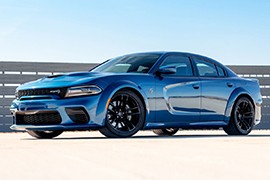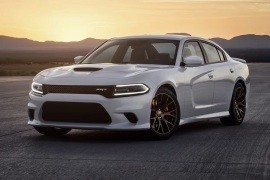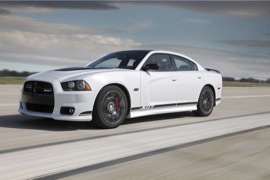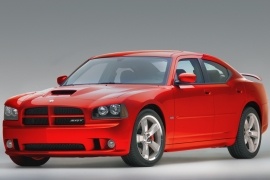DODGE Charger SRT Models/Series Timeline, Specifications & Photos
First production year: 2006
Engines: Gasoline
The fastest sedan in the world doesn't have a three or four-letter acronym, nor does it have a two-word name, and is a Dodge. The Charger Hellcat is, with its 707hp and 196 mph (300 kph) top speed, the fastest three-box sedan in the world, as of 2019. The 0-60 mph (0-96 kph) sprint is achieved in 3.9 seconds and the model deserved a better look. That's when the Widebody came.
The Widebody Hellcat Charger was first shown in 2019 and it has a mean look as standard for the Hellcat version, but the body kit is also available to order on the Charger Scat Pack. The wide body kit adds 3.5 inches (88.9 mm) to the width of the car, creating a more aggressive stance with a new set of fender flares, which are making room for a set of wheels with Pirelli 305/35ZR20 tires. Brembo six-piston front calipers with two-piece front brake rotors and unique suspension tuning with Bilstein three-mode adaptive damping combine to improve handling performance. The whole package fits the image for the 707 hp four-door muscle car perfectly.
A new, important improvement is the new EPS (electronic power steering), installed for the first time in the Charger. The Hellcat Widebody showcased the transition from a straight-line acceleration muscle car to a real sports sedan. The Hellcat Widebody can be more aggressive on the curves and can brake in a shorter distance. It was made to compete against European power-sedans, with a little help from the Italians, but still following the American way with a V8 6.2 supercharged gasoline engine.
The 2015 Dodge Charger has received two more powerful versions, named SRT and SRT Hellcat. Both were truly muscle cars in the disguise of a four-door sedan.
Europe had its four-door powerful mid-size sedans such as the F10 BMW M5 or the Mercedes-Benz E63 AMG. Dodge was the brand assigned by the FCA to build the most powerful vehicles in the U.S. lineup. The standard SRT featured a 6.4-liter V8 engine while the Hellcat version was offered with a supercharged 6.2-liter V8.
From the outside, both SRT versions featured a scoop on the hood, but the Hellcat also featured two vents to help cooling down the engine. On the front fascia, on the big grille in the bumper, there was a removable transverse panel for the license plate. In case that the owner would use the car on a track. SRT stood for Street & Racing Technology and it left its marks on the exterior look with a black mesh grille, aerodynamic side sills, and a trunk-spoiler. In the rear, the 4” exhaust tips were noticeable. From the outside, the big Brembo brakes were noticeable through the 20” light-alloy wheels.
Inside, both SRT versions featured bolstered front seats, but with better leather for the Hellcat version. Also standard was the 7” infotainment unit that could show performance data for the vehicle, such as the ¼ mile time, torque, power, oil pressure, etc.
The SRT was offered with a naturally aspirated, 492 hp engine, wile the Hellcat version, with its supercharged engine, boasted out 707 hp.
The upgraded version of the Charger SRT8 was revealed to the public in 2012.
The 2nd generation of the pure American muscle car had an aggressive fascia, with the bold, big black grille.
Keyless entry was standard across the entire Charger lineup, as well as keyless go.
The SRT8 featured the Chrysler 6.4-liter V8 engine, developing 470 hp. The engine was mated to an upgraded 5-speed automatic transmission. The heavy muscle car could rocket to 100 kph in just 4.4 seconds, close to the M3’s performance.
Inside the SRT8 we could find the same sporty design, with the same heated seats from the older generation.
The cupholders were both heated and cooled, a nice feature for a sports car.
The dashboard was refreshed with better quality materials. The steering wheel was flat-bottomed and was wrapped in leather. Behind the steering wheel, user could find the paddle shifters to change gears by their desire.
The up-to-date interior came with a 8.4-inch display that was fully customisable and offered detailed information.
Technology was not left behind for the SRT8, being equipped with blind spot monitoring, backup camera and rear sensing wipers.
The SRT8 had a 2 mode adaptive damping suspension, and while it was nothing new, together with the hydraulic steering, it offered a great driving experience on the track and on challenging roads.
Braking was also very effective, with the 4-piston Brembo callipers and big discs.
While we do remember the 60’s 2-door muscle car, the new models kept the formula and enhanced the ride quality as much as possible with improved comfort and practicality.
The Dodge Charger shared the same platform with the Dodge Magnum and the 300C, however, it offered a roomier interior and an enhanced ride.
What differentiated the Charger from the two siblings was the “less powerful” engine available for the SRT8. The Charger started straight with a 3.5-liter V7 powerplant that developed 250 hp.
The Charger was available in a sedan body shape only and offered two trim levels, the base SE and the R/T.
The base level came with 17-inch steel wheels, air-conditioning, keyless entry, cruise control, ABS and a tilt/telescoping steering wheel.
An additional package was available for the SE and added aluminum wheels, a better audio system, leather-wrapped steering wheel, fog lamps and chrome accents inside and out.
The R/T came with the incredibly powerful 5.7-liter Hemi V8 engine with 340 hp, along with dual exhaust pipes, bigger brakes and leather upholstery. The alloy wheels were brought to 18-inch.
More packages were available, such as the Daytona R/T package and a Road/Track Performance Group. The latter excluded the cosmetic details added by the Daytona R/T package and was less expensive.
The interior offered great room for both the front and the rear passengers. The styling was not out of the ordinary, however, the dashboard had a clean design and the controls were intuitively placed and easy to use.



